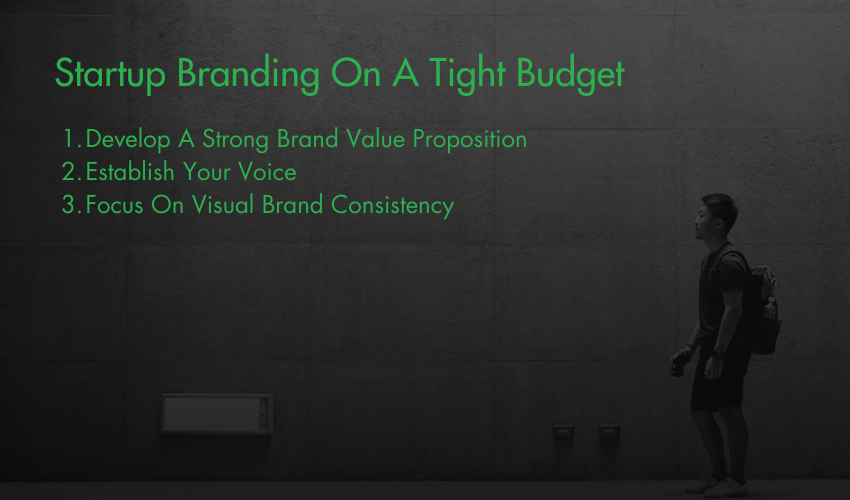What do Coca Cola, Ford Motors, Nike and Apple all have in common? Besides being multi-billion-dollar businesses, these companies all have strong branding that’s recognized throughout the world.
For tech startups, branding is just as important as it is for these global businesses because a great brand grabs the attention of potential customers, establishes your business’s identity, and builds customer affinity and loyalty.
To achieve these results, however, your brand needs to go beyond a “cool” logo, colors and fonts. To do it right, you need to develop a story that represents your business and its core values through design, content, personnel and more—and you can do that on a tight budget.
To develop your startup brand, keep these simple tips in mind.

Step 1: Develop a Strong Brand Value Proposition
Not to be confused with a motto or slogan, your value proposition is a statement that summarizes what your company does, why it’s unique, and why a customer should purchase your product or service.
Think of it as your “elevator pitch,” which communicates to customers what your company stands for.
A value proposition is important because it guides your entire brand strategy, from content creation to website design and everything in between.
Most importantly, it ensures that your messaging consistently represents your brand accurately across all marketing channels.
To develop this critical piece of your brand, ask yourself the following questions:
- Who is your target customer and what are their main pain point(s)?
- What is the benefit of using your product or service and how does it solve your customers’ problem?
- What makes you different from indirect and direct competitors?
For example, your answers might be:
- Our customers want a high-quality protein powder that’s available for a reasonable cost.
- Our product is organic and uses all-natural ingredients while costing $3 below the average cost for similar products.
- We’re different because we’re our target customers. We use our protein powder and we live and breathe fitness just like they do. We’re not just another manufacturer.
As such, your value proposition might be Affordable organic protein powder, created by athletes like you.
Step 2: Establish Your Voice
When your value proposition is set, you can develop a strong brand voice. Your brand voice specifies the way you communicate with your customers, including the words you use and the tone you take.
For example, a brand voice might be intellectual and sophisticated versus silly and informal.
To figure this out, write down words that describe your brand as a person. If we continue the protein powder example, those words might be:
- Informed
- Athletic
- Committed to health
- Understanding
- Relatable
From this brainstorm, you might decide that an informal yet informative tone is best. This means, you use some technical jargon in posts and on your website, but you have fun with it, defining terms in a way that shows you know what you’re talking about but you’re not being snobby.
Remember that this will change over time. As your product evolves, and your customers’ needs evolve, your messaging might ebb and flow with those changes as well.
Step 3: Focus on Visual Brand Consistency
As a startup, brand consistency is critical because consumers are just starting to get to know your brand.
You want to make it easy for them to recognize you, whether they find you on social media or visit your website.
Disjointed branding can lead to miscommunication, confusion and the erosion of trust, as customers don’t know what to expect.
This is why you should consider using the same brand name as part of your online identity. A smart way to do this is to adopt a new domain extension like .online to denote your startup on the web.
Consistent branding and messaging help to drive positive customer sentiment, loyalty, and trust. Customers know that every time they visit your brick-and-mortar store or website they will get the same, pleasant experience.
While you need to maintain consistency in your messaging, sticking with the brand voice that you’ve developed, it’s just as important to maintain visual brand consistency.
This begins and ends with design, whether you’re creating a social media post or a flyer for your grand opening event and includes:
- Brand colors
- Fonts used
- Image style
- Logo
Luckily, you don’t need a full design team to get started. There are many tools available to help with creating and organizing visual assets for little to no money, like MyCreativeShop.
Check out how you can use their tool to create your visual branding strategy, even as a newbie designer.
Don’t forget to compile all of the final brand details into your brand style guide, which will ensure that anyone who creates graphics maintains that consistency.
If you’ve never done that before, check out 99 design’s brand guide blog post.
Create Your Brand on a Budget
Creating a strong brand doesn’t require a big marketing budget or a team of savvy marketers.
Rather, the name of the game is consistency and getting all the foundational elements in place. This allows you to establish yourself as a brand and ultimately attract the right customers.
Author Bio
 Jessica Thiefels is an entrepreneur and founder and CEO of Jessica Thiefels Consulting. Follow her on Twitter @JThiefels and connect on LinkedIn.
Jessica Thiefels is an entrepreneur and founder and CEO of Jessica Thiefels Consulting. Follow her on Twitter @JThiefels and connect on LinkedIn.

